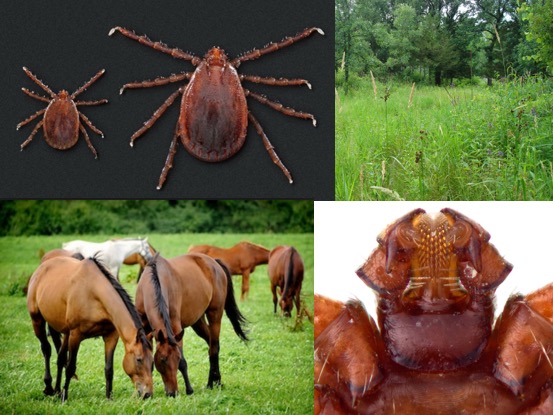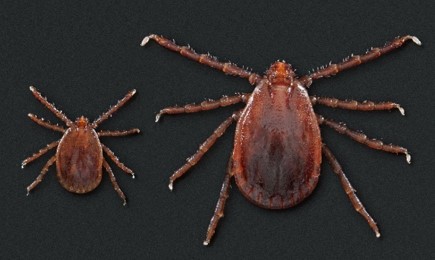Need to finish presentation

Forest Edges

Asian longhorned ticks are commonly found along forest edges and along trail clearings. Keep grass and weeds trimmed and clear overgrown brush in pastures and yards to reduce habitat areas. After each bloodmeal, the tick falls off its host and either develops to the next life stage or, if it is an adult female, will lay its eggs under the leaf litter. A single female can lay between 2,000 and 4,000 eggs, and can reproduce without mating with a male. In general, nymphs will be most active in the spring, adults in the summer, and larvae in the fall. In some locations, however, all three life stages may be active in the same season and can develop from egg to adult in 6 months.
Image credit: Wikimedia
Identification

Asian longhorned ticks are light brown and do not have distinctive markings on their scutum (back). The adult female (right side of the image) grows to about 10mm (0.4 in) in length when bloodfed and has a large spur on its basal palpal segment, which is a portion of the mouthpart. Males are rare and to date have not been found in the US. Immature lifestages are very small: nymphs (left side of the image) are about the size of a poppy seed and larvae are even smaller.
A very similar species, the rabbit tick (Haemaphysalis leporispalustris), is native to the US and is commonly found on wild rabbits and hares. That tick is not known to cause problems for other species, including humans. The Asian longhorned tick is easily misidentified or confused with other tick species. If you suspect the presence of non-native Asian longhorned ticks contact your local extension office for sample submission. A distinguishing characteristic of the Asian longhorned tick is the large spur on the lower portion of the mouthpart. The most commonly encountered ticks in Tennessee include the Lone Star tick (right side of the image) and the American dog tick, while Gulf Coast tick and Blacklegged ticks are also found.
Image credit: CDC
At-Risk Species and Prevention Methods

Thus far, 17 different mammal species and one avian species have been infested with Asian longhorned ticks. Mammals include sheep, goats, dogs, cats, horses, elk, cattle, deer, opossums, raccoons, foxes and humans. The single avian species was a hawk, which is also a predator to mammals. This list continues to grow as more tick surveys are conducted in the infested areas. Standard tick treatment regimens should be effective against the Asian longhorned tick, as this tick is currently susceptible to permethrin. Livestock and pet owners should consult with their veterinarian to determine the best tick prevention program for their animals.
Image Credit: Shutterstock